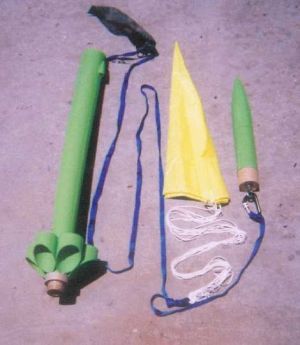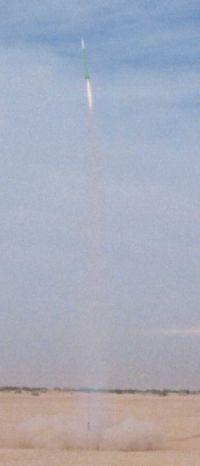Scratch Fahrenheit XL Original Design / Scratch Built
Scratch - Fahrenheit XL {Scratch}
Contributed by Larry Brand
| Manufacturer: | Scratch |
| Style: | Ring/Tube/Cone Fin |
 Brief:
Brief:
Fahrenheit XL is a scaled-up 38mm version of my PVC tubefin rocket, Fahrenheit 62/5. It is designed to fly on any H-I motor and has flown extremely well on CTI J330 power, so its suitable for L1 and L2 attempts. Like all tubefin designs, it is stable, wind resistant, and very quick and easy to build. Since this time (for a change) I used all primo grade rocketry hobby materials to build Fahrenheit XL, instead of assorted scrounged junk, it is not particularly inexpensive. This results though in one of the nicest looking tubefin rockets I have seen, almost as nice as a "normal" 4FNC rocket. Because the airframe everywhere is double thickness, Fahrenheit XL is as strong as a brick outhouse--it was actually designed for 54mm power.
Construction:
Construction is entirely from LOC components:
- 34" 54mm motor tube used as the main body
- 54mm connector tubes (6 needed) were used to double-wall the entire airframe, including the tubefins
- 54mm LOC ogive cone and LOC 6"x54mm payload bay kit
- No centering rings used, a LOC 54mm-to-38mm motor adapter was used to hold the engines, sometimes together with a 29mm adapter
- Recovery system was 20' of 5/8" nylon webbing to a 36" LOC chute
- Launch lug is 6" of 5/16" heavy wall aluminum tubing
Construction was generic tubefin process using 5-minute Devcon epoxy, except that 6" x 54mm connector sections were used to double the airframe. Tubefins were cut with a 45 degree bevel on the bottom and were 3 1/4" (long side) x 1 5/16" (short side). The coupler was 1 5/16" long and did not extend into the beveled area. Tube fins were attached in pairs in the usual self-jigging fashion for tube fin rockets. Recovery system is anchored to an 8" loop of para cord, pushed through a hole drilled 4 1/2" from the top of the body tube, with the knot covered by half of a bisected Estes BT-5 nose cone. Center the 6" launch lug 6" above the tubefin can. CG at AUW should never be aft of this balance point. Long, heavy motors actually increase tubefin rocket stability. Payload bay contained 400g lead fishing sinker ballast in a plastic bag (total rocket weight empty is 1275g) for I-J flights only. A special LOC cone with 135g additional ballast is used to keep overall speed down. The Perfectflite MicroAlt altimeter used for most flights was placed loosely rolled in a piece of paper towel inside a 3" section of 29mm motor tube placed in the payload bay on top of the lead ballast. All in all, not a lot of work for a L1-L2 capable rocket.



Finishing:
Finish was with lime green Testor's spray (and no primer used).
Flight:
Flights were made on the following motors: AT G80T-4, CTI J330-10, CTI I287SS-9, Ellis Mountain H275-6, Ellis H275-10, Ellis I134-10, CTI H143SS-8. Very straight flights in each case with trouble free ejection, except the time I tried a 50" chute, which failed to fully eject due to having been packed too tightly. The rocket flat spun to the ground and landed on its side undamaged. Maximum altitude achieved was 3428' (at 580 mph) on the J330-10 power, which would be a convenient, reasonably low altitude for an L2 seeker. Flights on H143SS-8 gave 1348' and 1388', equally nice for cert flying. Although I was pleased with the Fahrenheit XL flight performance and appearance, I have to admit being kind of disappointed with its aerodynamics--calculation of minimum drag coefficient indicated a minimum Cd value of 2.13 at 580 mph. Not good. Its little brother, Fahrenheit 62/5 achieves a minimum Cd of 1.6 (that's not bad for tubefins). I'm not sure why this is.

Summary:
PRO: Very easy and quick to build, no centering rings, use of only a 38/54mm adapter works great, even with J-power. Excellent stable climbs, not too high (good for L1-L2-cert). Actually nice looking, a rarity for tubefin jobs. Very strong and resistant to hangar rash. Small size for a L2-rocket that easily fits in a Miata with 2 people (we did this).
CON: Not cheap to build. High drag coefficient, which limits maximum climb. Need to use care in packing in more than a 36" chute for heavy motors (you can substitute para cord for the webbing).
Sponsored Ads
 |
 |











